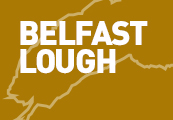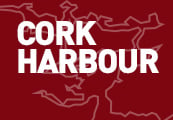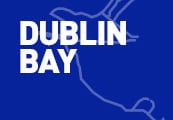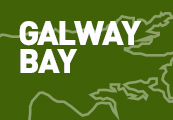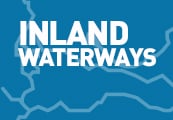Displaying items by tag: biodiversity
Hopes for Concrete Blocks With Imprint of Ringaskiddy Shoreline to Boost Biodiversity in Dublin Bay
Dublin’s Great South Wall has taken on the appearance of the Cork Harbour shoreline thanks to a new biodiversity project.
According to RTÉ News, a series of large concrete blocks imprinted with a mould of the Ringaskiddy coastline have been placed at the foot of the wall — providing a rougher topography that is hoped will be a safe haven for marine micro-organisms to thrive.
Researchers at UCD who developed the scheme chose the nooks and crannies on the water’s edge at Ringaskiddy above more than 60 other shorelines, both naturally rocky and human-made, as the model for their project in collaboration with the Dublin Port Company.
And if the Dublin Bay experiment is successful, then Ringaskiddy’s topography could be replicated on sea walls, piers and other structures around the country.
RTÉ News has more on the story HERE.
Seafood, Biodiversity and Flood Risk Management Among Themes of Draft New Climate Adaptation Framework
Flood risk management, biodiversity, seafood and water quality are among themes of the Government’s national adaptation framework on climate which has been opened for public consultation.
Minister for Environment, Climate and Communications Eamon Ryan marked the opening of the month-long public consultation on Friday, 19 January on the National Adaptation Framework (NAP).
The current National Adaptation Framework was published in 2018 and outlines a “whole-of-Government and society approach to climate adaptation in Ireland”.
A review in 2022 recommended the drafting of a new National Adaptation Framework.
The framework takes a sectoral approach, which aims to “improve the enabling environment for adaptation through ongoing engagement with the key sectors and local government, along with civil society, the private sector, and the research community”, his department says.
The so-called Sectoral Adaptation Plans (SAPs) are assigned to the line Ministers responsible for priority adaptation policy areas, and include the flood risk management under the remit of the Office of Public Works (OPW).
Six Government Departments are currently leading in the implementation of the nine SAPs covering 12 key sectors under the Climate Action and Low Carbon Development Act 2015-2021.
Other sectors include seafood, agriculture and forestry under the Department of Agriculture, Food and Marine, transport infrastructure under the Department of Transport, and biodiversity and water quality under the Department of Housing, Local Government and Heritage.
The Department of Environment says that climate adaptation is “the process of adjustment to actual or expected climate change and its effects”.
“It is not a one-time emergency response, but a series of proactive measures that are taken over time to build the resilience of our economy and society to the impacts of climate change. Adaptation ultimately seeks to minimise the costs of climate change impacts and maximise any opportunities that may arise,”it says.
The public consultation runs until February 19th and more information is here
Inland Fisheries Ireland Welcomes Oireachtas Committee Report on Biodiversity Loss
Inland Fisheries Ireland (IFI) has welcomed the publication on Thursday (14 December) of the Joint Committee on Environment and Climate Action’s Report on the examination of recommendations of the Citizens’ Assembly report on biodiversity loss.
Speaking at Leinster House, IFI chief executive Francis O’Donnell said: “Inland Fisheries Ireland, as a key State environmental agency, is a major stakeholder in protecting and restoring biodiversity in Ireland’s freshwater and coastal waters.
“I welcome the report and its recommendations, and was pleased to provide oral testimony to the committee.
“IFI’s objectives are reflected closely in the committee’s own recommendations. We want additional powers and resourcing for enforcement officers. And we seek enhanced cross-collaboration between relevant State agencies to better respond to both wildlife and fisheries crime, and pollution incidents.”
O’Donnell continued: “Our call for a review of sanctions and penalties associated with breaking environmental laws is also echoed in this report.
“Separately, with the support of the Department of Housing, Local Government and Heritage, and the Department of the Environment, Climate and Communications, Inland Fisheries Ireland has developed a National Barriers Mitigation programme. This initiative will remove, where possible, and mitigate the environmental impact of river barriers for fish species.”
O’Donnell added that IFI “is committed to expanding our efforts to restore and protect our environment and enforce legislation where necessary, particularly where it can support the restoration of aquatic biodiversity”.
Cornish Harbour Gets ‘Living Wall’ to Promote Biodiversity
A Cornish harbour has teamed up with a local environmental charity to install a set of special tiles to make a ‘living wall’ for marine wildlife and plant life.
According to Marine Industry News, the ‘Habitiles’ now in place in Falmouth Harbour are designed with nooks and crannies for marine life to proliferate where it normally wouldn’t in a flat-walled harbour.
“We’ll see seaweeds and algae making their home here which then provide shelter and food for small invertebrates which in turn become a food source for larger animals,” said Tina Robinson from charity Our Only World.
The tiles are manufactured locally from byproducts of the granite and quarrying industries, and manufacturer ARC Marine says their production will soon be carbon-neutral.
Similar installations in Plymouth and Australia use tiles made by Sydney-based Living Seawalls, which recently signed a production and supply partnership for the UK and Ireland with Co Offaly’s Inland and Coastal Marina Systems (ICMS).
Marine Industry News has more on the story HERE.
Pond Creation for Biodiversity Theme of Workshop in Galway
How to create and manage a pond as a reservoir for biodiversity is the theme of an event hosted by An Taisce in Galway later this month.
An Taisce is running the project in association with Galway City Council, and involves a morning workshop given by An Taisce pond advisor Féidhlim Harty on Saturday, September 30th.
Harty will give a talk in the Clayton Hotel, Ballybrit, Galway, on pond creation and management.
He will then host a walk around a new pond in Merlin Woods, which is a five-minute drive or 20-minute walk from the hotel.
The free event will involve refreshments. Good footwear, warm clothes and rain gear is advised. Booking is “essential”, Galway City Council says.
More details are here
 How to create and manage a pond as a reservoir for biodiversity is the theme of an event hosted by An Taisce in Galway later this month
How to create and manage a pond as a reservoir for biodiversity is the theme of an event hosted by An Taisce in Galway later this month
State of Marine Food Webs Changing - OSPAR Report for North-East Atlantic
The state of marine food webs is changing, according to the OSPAR quality status report for the northeast Atlantic.
The report, published this week, highlights how a loss of marine biodiversity, pollution and climate change continue to affect the North-East Atlantic.
Among a myriad of findings, the report concludes that climate change and ocean acidification, which is caused by the sea’s increased uptake of carbon dioxide from the atmosphere and which impacts the ability of organisms to form shells and skeletons, are important drivers of change in the north-east Atlantic, in turn threatening marine biodiversity.
It also presents further evidence that marine food webs are changing. Improvements in relation to human activities have, however, been recorded in a number of areas, such as the prevention of pollution by radioactive substances and a reduction in negative impacts from oil and gas activities.
Minister for Heritage Malcolm Noonan said that “as living witnesses to a changing Atlantic, it’s crucial that we regularly and rigorously gather the science and present the evidence that tells us how our marine environment is doing, and that we do that in concert with our neighbours in the UK, mainland Europe and our Nordic and Icelandic partners”.
“OSPAR and the QSR 2023 [quality status report] provide that platform, to work together for our shared marine environment and to point out where decisive action is needed to protect it and restore it,” he said.
“For Ireland, the QSR 2023 assessments indicate how the comparatively lower level of urbanisation and industrial activity around our coasts and in our seas has so far afforded us a relatively clean, healthy, diverse and productive marine environment,” Noonan said.
“ However, it’s clear that the identified wider and growing challenges posed by climate change, biodiversity loss and pollution, including marine litter, and the ongoing poor status of many marine species and habitats demonstrate a clear need for further coordinated action by OSPAR Contracting Parties.
The Marine Institute and Environmental Protection Agency also commented on the report and how it is helping Ireland to better understand the quality of the marine environment around Ireland.
Ireland is one of 16 parties to the OSPAR Convention, and the report sets out the evidence to inform important international and national decisions on how to improve this vital environment.
The QSR 2023 results from the combined efforts of over 400 experts, scientists, data analysts and policy colleagues, supported by contributions from OSPAR observers coming from industry, environmental non-governmental organisations and international partner organisations.
‘Environmental DNA’ Data Collection in The Ocean Race Could Provide Crucial Insights on Ocean Biodiversity
Environmental DNA, known as eDNA — one of the most cutting-edge ways to measure ocean health and biodiversity — was collected during The Ocean Race 2022-23 in a world first for racing boats.
11th Hour Racing Team, winners of the six-month long round-the-world race, took samples during the 5,550-nautical-mile Leg 4 from Itajai in Brazil to Newport in Rhode Island, USA in a pioneering initiative of The Ocean Race’s science programme, which aims to support understanding about the state of the seas.
Twenty-seven water samples were gathered between 23 April and 10 May this year and later analysed by the Cawthron Institute, New Zealand’s largest independent science organisation. Each sample included genetic material contained in microbes or shed by thousands of marine species through their waste products and skin cells.
Analysis of this eDNA gives a comprehensive snapshot of the presence and diversity of these species with high accuracy. These data are valuable for a number of reasons, including helping to track endangered species, monitoring diseases and pathogens. And when samples are compared over time, eDNA can provide insights into how the climate crisis is affecting marine life, for example, by shifting their geographic range.
Among the key findings of The Ocean Race eDNA collection was a striking correlation between the abundance of ocean bacteria (Pseudomonas and Acidobacter) that break down plastic and latitude, with analysis showing the highest levels of the bacteria (meaning greater plastic degradation) at lower latitudes near Brazil’s coastline.
 Amory Ross lead the eDNA sampling onboard 11th Hour Racing Team | Credit: Amory Ross/11th Hour Racing/The Ocean Race
Amory Ross lead the eDNA sampling onboard 11th Hour Racing Team | Credit: Amory Ross/11th Hour Racing/The Ocean Race
While data from a single boat means that findings aren’t conclusive, The Ocean Race says this discovery highlights the powerful role of this type of eDNA technology and the need for further research. Understanding more about the geographic spread of these bacteria could provide valuable insights to help fight the marine plastic crisis.
Analysis also found that parasitic bacteria (exo or intracellular parasites) — which can be a threat to the health of other species, including humans — are strongly linked with increased sea surface temperature and longitude, with higher abundances closer to landmasses.
With record-breaking ocean temperatures documented in recent months, the influence of changing ocean temperatures on pathogenic microorganisms is another crucial area requiring further research.
Xavier Pochon, team leader of molecular surveillance at the Cawthron Institute and associate professor at the University of Auckland said: “We’re very excited about the data collected during The Ocean Race, particularly those linked with pathogens and plastic degraders. These are interesting findings because very little is known about their distribution and ecology across large latitudinal gradients.
“Our eDNA collection system on racing boats offers significant benefits over traditional research methods as it allows scientists to audit biodiversity from across the tree of life, more rapidly, cheaply and with minimum hands-on time for the sailors. We are looking forward to equipping many more racing boats in the future and propelling our knowledge of marine life into uncharted waters.”
 Onboard 11th Hour Racing Team: three eDNA filters from the third sample set, all done and ready for processing with date and time recorded on the bags | Credit: Amory Ross/11th Hour Racing/The Ocean Race
Onboard 11th Hour Racing Team: three eDNA filters from the third sample set, all done and ready for processing with date and time recorded on the bags | Credit: Amory Ross/11th Hour Racing/The Ocean Race
As part of The Ocean Race’s science programme — one of the pillars of the Racing with Purpose sustainability programme that was created with premier partner 11th Hour Racing — the data collection was trialled across one leg of the 32,000nm (60,000 km) race, spanning a latitude of 27 degrees to 39 degrees, to test the feasibility of gathering eDNA on racing boats.
11th Hour Racing Team gathered the samples through an onboard OceanPack: a specialised instrument that measures a range of ocean data, including salinity, temperature, carbon dioxide, oxygen and trace elements.
The equipment worked automatically and continuously throughout the race; eDNA was sampled through the OceanPack — the vessel's existing seawater flow-through system — which pumps two litres of water through innovative eDNA filters for later lab analysis. Trialling eDNA sampling via the OceanPack had the advantage of providing scientists with the opportunity to cross check data and look for links and correlations.
Stefan Raimund, ocean advisor at The Ocean Race said: “Each sample collected contained millions of pieces of eDNA, from single-cell organisms, all the way up to lantern fish and the elusive Moray eel, providing a fascinating snapshot of life below the waves and how it changes throughout the Atlantic Ocean.
 The OceanPack is a specialised automated instrument with multiple sensors that measure a range of types of data about the ocean. 11th Hour Racing Team and Team Malizia carried the OceanPack onboard during The Ocean Race 2022-23 | Credit: Cherie Bridges/The Ocean Race
The OceanPack is a specialised automated instrument with multiple sensors that measure a range of types of data about the ocean. 11th Hour Racing Team and Team Malizia carried the OceanPack onboard during The Ocean Race 2022-23 | Credit: Cherie Bridges/The Ocean Race
“eDNA sampling is at the forefront of biodiversity testing and is a powerful tool for understanding ocean health and how the major threats of climate change and pollution affect it. The more we know about the ocean, the more effectively we can protect it.
“Having successfully trialled the sampling during The Ocean Race 2022-23, we hope to scale it up for future races and have more boats collecting this data, including in remote and vital parts of the ocean, where even less information is available for scientists.”
The potential of eDNA testing for understanding marine biodiversity has been increasingly lauded in the last few years for providing a holistic view of biodiversity without the drawbacks of traditional research methods like catching species and aerial surveys, which can be harmful, expensive and limited. eDNA can also provide fast results, which can be vital given the urgency of the problems impacting the seas.
The data were produced using Illumina next-generation sequencing technology. Cawthron Institute, who specialise in science that supports the environment and sustainable development, was also supported by Sequench Ltd and Smith-Root.
United Nations Members Agree on Unified Treaty to Protect Biodiversity in the High Seas
After more than 20 years, United Nations members have agreed on a new framework to protect marine life in international waters, as The Journal reports.
The historic treaty was reached late on Saturday night (4 March) at the UN Headquarters in New York following two weeks of discussions.
It will see the creation of a new body to manage conservation of ocean life as well as establish marine protected areas in the high seas.
The move could be a boon to migratory marine wildlife including whales, dolphins, turtles and fish — protections on which have until now been hindered by a lack of legislative unity across various ocean territories.
The treaty also sets ground rules for conducting environmental impact assessments for commercial activity. “It means all activities planned for the high seas need to be looked at, though not all will go through a full assessment,” said Jessica Battle of the Worldwide Fund for Nature.
President Michael D Higgins has welcomed the treaty as “a gain for the future of humanity”.
He added: “It is essential that attention now swiftly moves to formal adoption of the text, to ratification and to implementation.
“Time is of the essence if the 30x30 pledge made by countries at the UN biodiversity conference in December to protect a third of the sea by 2030 can be reached. A target which must be considered a bare minimum.”
NGOs Call for ‘Recasting of Legal Mandates’ for Public Bodies to Protect the Environment
In a letter sent to Irish ministers and other elected officials last week, three NGOs call on the Government to amend mandates and legislation to ensure public bodies are fit to deliver on Ireland’s climate, biodiversity and water objectives.
The Environmental Pillar, the Stop Climate Chaos Coalition and the Sustainable Water Network (SWAN) claim that “a lack of government oversight and accountability in the operation of public bodies is undermining Ireland’s response to the declared climate and biodiversity emergency”.
They also demand that “narrow economic mandates” conferred on public bodies like Coillte and Bord na Móna “must be immediately amended and brought in line with environmental and climate obligations at national and EU level”.
The groups call for public land “to be utilised in the public interest” and that all public bodies “be mandated to take the lead in Ireland’s response to climate change and biodiversity loss”.
“Public land must be utilised in the public interest and the Irish people should have a greater say in how that is achieved,” said Fintan Kelly of the Environmental Pillar.
“At a time when we are asking private landowners to do more in response to climate change and biodiversity loss, it is critical that the State is seen to lead from the front.
“The untapped potential of Coillte and Bord na Móna’s land holdings presents an unprecedented opportunity to restore nature at scale, delivering essential ecosystem services to society such as biodiversity restoration, climate change mitigation and adaptation, as well as employment and public amenity. This is an opportunity we can’t afford to ignore any longer.”
SWAN board member Dr Elaine McGoff added: “The actions of Coillte, Bord na Móna and the OPW, along with many other public bodies, have a substantial impact on the health and biodiversity of our rivers, lakes, wetlands, and seas.
“Forestry is the third most significant pressure on our waterbodies and is a key contributor to the loss of our most pristine rivers, down from five hundred to just twenty in the last few decades.
“Considerable damage to our water environment is also being caused by drainage and infilling of our bogs and wetlands by Bord na Móna and others, along with arterial drainage works on our rivers by the OPW.
“Wetland protection and restoration are recognised as key to solving our water, biodiversity and climate crises. If we are serious about improving water quality, the protection and restoration of our natural systems must be made core obligations for these public bodies by amending their legal mandates.”
National Biodiversity Plan To Be Put on Statutory Footing
Ireland’s plan to halt biodiversity decline in the marine and terrestrial environment is to be put on a statutory footing, Minister of State for Heritage Malcolm Noonan has said.
Mr Noonan also said he intends to introduce stronger biodiversity responsibilities for public bodies.
He was speaking at the UN Biodiversity Conference COP15 in Montreal, Canada.
The junior minister said a memorandum will be brought to Cabinet shortly, seeking to restore the Wildlife (Amendment) Bill 2016 to the Dáil order paper.
The Bill had completed all stages in the Dáil and the Seanad, but lapsed with the dissolution of the 32nd Dáil in January 2020.
He said that further work on drafting the Bill has been undertaken, and it is now ready to “recommence its journey through the Houses of the Oireachtas”.
The Bill underpins the National Biodiversity Action Plan in legislation and, once ratified, will require public bodies to submit regular reports to the minister which will outline the measures they are undertaking to relevant biodiversity plans,
“Putting the National Biodiversity Action Plan on a statutory footing and strengthening the biodiversity responsibilities of public bodies are long-held ambitions of mine,” he said.
“These proposals will significantly enhance Ireland’s ability to implement biodiversity action across the country,” he said.
“This couldn’t come at a more crucial time,” Mr Noonan added.
“ As 196 nations come together to agree an ambitious new set of global goals for nature at COP15, we know that what really matters is what happens on the ground. That’s what these new legislative measures are focussing on.”

